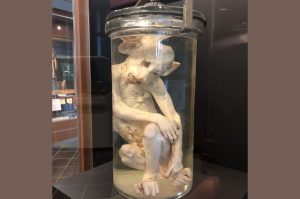 Our World
Our World  Our World
Our World  Miscellaneous
Miscellaneous 10 Timely Stories about Clocks
 History
History 10 Magnificent Heroines Who Went Undercover to Defeat the Nazis
 Music
Music 10 Surprising Stories Behind Famous Songs
 Weird Stuff
Weird Stuff 10 Crazy Things Your Body and Brain Do (Explained)
 The Arts
The Arts 10 Historic Instruments Worth More Than a Luxury Car
 Technology
Technology 10 Crazy AI Controversies… So Far
 Movies and TV
Movies and TV 10 Fictional Plagues We’re Glad Aren’t Real
 Weird Stuff
Weird Stuff 10 Mind-Blowing Incidents and Strange Finds in the Drive-Thru
 Miscellaneous
Miscellaneous 10 Famous People You Didn’t Know Killed Someone
 Our World
Our World 10 Terrible Crimes That Are Destroying the Amazon
 Miscellaneous
Miscellaneous 10 Timely Stories about Clocks
 History
History 10 Magnificent Heroines Who Went Undercover to Defeat the Nazis
Who's Behind Listverse?

Jamie Frater
Head Editor
Jamie founded Listverse due to an insatiable desire to share fascinating, obscure, and bizarre facts. He has been a guest speaker on numerous national radio and television stations and is a five time published author.
More About Us Music
Music 10 Surprising Stories Behind Famous Songs
 Weird Stuff
Weird Stuff 10 Crazy Things Your Body and Brain Do (Explained)
 The Arts
The Arts 10 Historic Instruments Worth More Than a Luxury Car
 Technology
Technology 10 Crazy AI Controversies… So Far
 Movies and TV
Movies and TV 10 Fictional Plagues We’re Glad Aren’t Real
 Weird Stuff
Weird Stuff 10 Mind-Blowing Incidents and Strange Finds in the Drive-Thru
 Miscellaneous
Miscellaneous 10 Famous People You Didn’t Know Killed Someone
10 Animals That Turned Out to Be Hoaxes or Spoofs
When drawings and dried skins of the platypus first arrived in Europe from Australia at the end of the 18th century, no one knew what to make of it. A swimming mammal that laid eggs and had a bill like a duck. Many scientists were skeptical. Some searched the preserved examples for stitches, which might reveal it was made by joining a duck’s beak to an animal like a beaver. The natural world is full of wonders, and even today, we can sometimes question whether the marvels we see are genuine or not.
Here are ten animals that have been reported, which turned out to be elaborate hoaxes or spoofs designed to fool the public.
Related: Top 10 Old-Timey Hoaxes People Actually Fell For
10 Archaeoraptor
The theory that birds evolved from dinosaurs is one of the most intriguing ones in all of evolutionary history. Since the discovery of Archaeopteryx—with its mix of dinosaur-like anatomy and avian features like feathers—in the 19th century, scientists have been searching for more fossils linking the two groups of animals. With further discoveries, it is now almost certain that birds evolved from the maniraptoran dinosaurs. Any fossil that sheds further light on this link is an important one.
In 1999, National Geographic held a press conference where they announced the discovery of Archaeoraptor—which they called the “missing link” between dinosaurs and birds. The announcement of such a find by a popular magazine instead of a reputable peer-reviewed journal is unusual. Both the journals Nature and Science had rejected papers on Archaeoraptor because of possible fraud.
It turned out that the fossil had been pieced together from parts of a feathered dinosaur and a separate dinosaur fossil. It was possible to match the fragments of the Archaeoraptor tail with the fossil of a known dinosaur exactly. Other parts of the fossil could be traced to other animals. National Geographic published a later article presenting evidence against their earlier announcement.[1]
9 Ompax spatuloides

In 1872, Karl Theodor Staiger, the director of the Brisbane Museum, was served a most peculiar fish for dinner. The fish had a wide body, a long tail, an unusual head, and a large spoon-shaped nose. When he asked about the fish, he was told it had been caught by locals in a nearby river. The fish was already cooked by the time Staiger saw it. Still, he knew this was certainly a new discovery, so he drew it at once to ensure others would know about what he had been given to eat.
With this drawing, another scientist, Francois Laporte, was able to describe the new species and give it the scientific name Ompax spatuloides. Given this official backing, the Ompax entered the list of known species inhabiting Australia. Because the land was so vast and Ompax was probably rare, it was not considered that strange that no one ever found another example.
It was only in 1930 that one of the hoaxers owned up. They had created the Ompax by joining together the tail of an eel, the body of a mullet, the head of a lungfish, and the bill of a platypus.[2]
8 Piltdown Man
The early 20th century in Europe was a time of great nationalistic rivalries between the imperial powers. This contest for supremacy stretched even into paleontology. With German and French researchers discovering evidence of early Neanderthals, it was felt to be a stain on Britain that they had no ancient humanoids to boast of. In 1912, this all changed when Charles Dawson, an amateur archaeologist, announced to the world that he had discovered the missing link between man and apes in Piltdown, Sussex.
The skull he produced appeared to have a cranium similar to a modern human, but the jaw looked distinctly ape-like. This would make it key to understanding human evolution. The skull had unfortunately been shattered while it was being dug up, so it had to be reconstructed. When this was done, it revealed Piltdown man to have a smaller brain than modern humans.
The discovery was announced as a new species called Eoanthropus dawsoni—Dawson’s Dawn Man.” Alas, many questioned the findings immediately. The reconstruction of the skull was challenged, and when reanalyzed, it was found that it could easily be a modern human with a normal brain. The jaw and teeth could also just be taken from an ape.
In 1953, Piltdown Man was conclusively proven to be a fraud. Dating the skull showed it came from a medieval man, and the jaw was from an ape that lived no more than 500 years ago. The fossils had been stained with easily obtained chemicals to make them look older. No one can say definitively who faked Piltdown Man, but it is interesting that the only person who ever found pieces of the fossil was Charles Dawson.[3]
7 Smaugia volans
On the 1st of April, the scientific journal Nature published an article on the amazing discovery of a dinosaur with six limbs. This would be unique as all vertebrates descended from a creature with just four limbs. A nearly complete skeleton of the dinosaur, which resembled a large velociraptor (apart from the extra limbs), was found by Randy Sepulchrave in North Dakota. Interestingly, given the link between dinosaurs and birds, it seems that this dinosaur could also fly.
Given the scientific name Samugia volans, from a Latin word meaning to fly, it appeared to have bat-like wings attached to its shoulders. It is also mentioned that the ribs of Smaugia show evidence of burning that was not seen on any of the other bones, which makes it look like they were exposed to fire repeatedly.
Smaugia is, of course, an April Fool’s joke played by the most famous science journal in the world. The name Smaugia is taken from the dragon Smaug in The Hobbit. Even the discoverer’s name, Sepulchrave, is related to a character in the Gormenghast books who is driven mad when his library burns down and dies when he comes to believe he is an owl and attempts to fly from his castle.[4]
6 Gellisoni fabricata

Another April 1st discovery was announced in 1939 in the Honolulu Star-Bulletin. A visiting Norwegian scientist, Dr. Thorkel Gellison, had caught what turned out to be the “biggest fish ever caught in Hawaiian waters, or any other waters outside the fairy tale books.” To show its readers just how immense this prodigious fish was, the newspaper printed an image of Dr. Gellison riding atop the fish as it was carried on a truck through the streets of Honolulu.
The accompanying report describes how the fish, Gellisoni frabricata, was landed. Gellison used dry bait, a copy of the Congressional Record as nothing is dryer, and a simple Mason Dixon line to catch the fish, which took four tug boats to drag to shore. Gellison was not so impressed by the huge fish as he told the paper that in Norway, large fish are well known and often ridden in the sea with a saddle. Alas, this example of a giant fish died of a broken heart when captured. Gellison bid reporters a hearty, Norwegian “Lirpa Loof!” as he departed.
Even without the April Fool anagram at the end of the article, few readers would have been truly taken in by this tallest of fishermen’s tall tails.[5]
5 Pacific Northwest Tree Octopus
The Roman writer Pliny the Elder described how an octopus loved to come on land and steal food as it was fermenting. The people got so fed up with the raids that they set up a high fence. The octopus was not deterred as it simply climbed a tree over it and took the food. In the end, only a mob with dogs and huge spears could dispatch the tree-climbing octopus.
It seems that in the forests of the Pacific Northwest of the United States, there is a species of octopus that spends most of its time in the trees. Octopus paxarbolis, to give it its scientific name, reaches about 1 foot in size and is amphibious. It spends most of its time in the trees and returns to water to breed. Alas, the Tree Octopus is an endangered species due to habitat loss and predation by cats and Bigfoot.
That, at least, is what a website that went online in 1998 told the world. Because a number of people fell for this hoax, it was used to study how people dealt with false information in the early days of the internet. It was selected by the Library of Congress as one of 30 websites to be preserved in its Web Culture Archive.[6]
4 Martian Monkey

The 1950s saw a surge in UFO sightings. With the space race in full swing, science fiction films showing terrifying aliens, and Cold War panic, it was easy for any stories involving possible extraterrestrials to spread quickly. In 1953, a police officer in Georgia stumbled across a remarkable scene. Three young men were standing around a scorched patch of earth in the middle of which lay a diminutive green figure. The men claimed to have seen more of these creatures and a UFO. After hitting one with their truck, the other creatures ran back to their craft and flew away.
The recovered body was shown to a local veterinarian, who said it looked like something out of this world. As the story got out, many people claimed to have seen a UFO in the sky around the time the first witnesses had. Had the United States got its hands on a genuine alien?
No. The three witnesses had staged the entire event. They took a dead rhesus monkey, cut off its tail, shaved it, and dyed it green with food coloring. All this was discovered when university professors examined the body and said, “If it came from Mars, then they have monkeys on Mars.” The Mars monkey is now in the Georgia Bureau of Investigations crime lab museum.[7]
3 Lake George Monster
In 1904, artist Harry Watrous and newspaper editor William Mann had a fishing competition. The one who caught the largest trout would be declared the winner. When Mann held up a huge monster of a fish, victory seemed to be his—until Watrous realized it was just a wooden model. So Watrous decided to play his own prank.
Watrous recalled how “I got a cedar log and fashioned one end of it into my idea of a sea monster or hippogriff. I made a big mouth, a couple of ears, like the ears of an ass, four big teeth, two in the upper and two in the lower jaw, and for eyes, I inserted in the sockets of the monster two telegraph pole insulators of green glass.” He then attached the log to a rope which would move the log from the shore. The next time Mann was out fishing with guests, Watrous pulled the rope and released the monster. One guest screamed while another beat at it with her parasol. Watrous pulled the monster back under and began to have it appear around Lake George at random.
Rumor soon spread about Georgie the Lake George Monster. Watrous later revealed his secret, and the monster can be seen in the Clifton F. West Historical Museum, New York.[8]
2 Gef the Talking Mongoose
The Irving family lived on a remote farm on the Isle of Man in the 1930s. When they heard strange noises, they assumed it was just a rat that had got into the walls. You can imagine their surprise when what emerged was a mongoose, and not just any mongoose—this one could talk. It cordially introduced itself as a mongoose called Gef, who had been born in New Delhi in 1852. Gef explained one day that he was “a ghost in the form of a mongoose” and “an extra, extra clever mongoose” on another. The Irvings fed Gef biscuits and milk.
The tabloids in England had a field day, and journalists descended on the farm. Investigators of the paranormal also turned up. No one could find evidence of Gef, but several others claimed to have heard his voice. When the Irvings moved out of the farm, the new owner claimed to have shot Gef. He produced a body to prove it, but it did not look like the Gef who had been described earlier.
Unlike the other hoaxes on this list, no one has ever conclusively proved it was a hoax. The daughter of the Irving family insisted Gef was real until her death in 2005. Perhaps the talking mongoose is still out there?[9]
1 Feejee Mermaid
Strange creatures lurking in the depths of the ocean have always fascinated us. Tales of mermaids stretch back to antiquity, and many sightings have been reported over the centuries. In 1493, Christopher Columbus claimed to have seen some in the New World, though he did not think them as pretty as they had been described in the past. Since he was probably looking at manatees, his disappointment is understandable.
Those who wanted to see a mermaid for themselves in the 19th century had only to go to a circus or sideshow where they might be shown a Feejee, or Fiji, mermaid for a small fee. Wealthy collectors also tried to buy examples for themselves. These dried remains of mermaids showed a large fishtail, a small ribcage with mammalian arms, and a little head packed with sharp teeth. Not a beautiful sight either.
Many of these mermaids have been acquired by museums, but none have turned out to be genuine. Most were made by joining fish and monkey remains together, with extra parts being added to make them look even more mysterious.[10]








